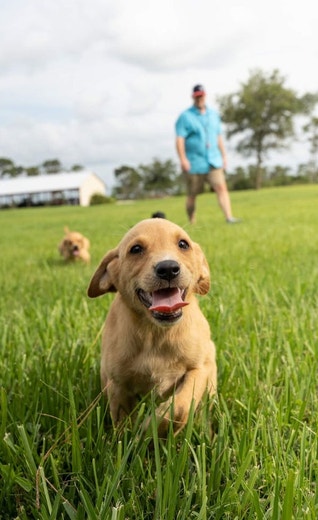
How Much To Feed A Sporting Breed Puppy
Featuring Russ Kelley, M.S., Eukanuba and Royal Canin Pet Health and Nutrition Center
Puppies are a lot of things. They’re curious, they take a lot of naps, and when they wake up they’ve got a tremendous amount of energy. They’ve got powerful appetites and are always on the lookout for the next meal. But there’s more to feeding a puppy than filling up a bowl with kibble.
FEEDING YOUR PUPPY IS A PROGRESSIVE GAME
Feeding sporting breed puppies is a progressive game that includes two primary goals. The first is that the volume puppies are fed helps them arrive at their ideal adult weight. The second is that their feeding routine should help puppies arrive at that target weight at the age-appropriate time.
Russ Kelley, Eukanuba’s Scientific Services Nutritionist, says puppy weight gains should be progressive and consistent. “When feeding puppies, it’s best to start with the feeding recommendations found on the manufacturer’s bag,” he said. “Then, break that total daily volume into smaller portions that you can feed on a regular basis. Most puppies follow a similar daily schedule; they wake up from a nap, they want to eat, then they want to play, and then they want to nap. Feed them on a regular schedule, between 3 and 4 times a day. Maintain that routine until the puppy is around four months old. At that point, reduce to twice-daily feedings, with one in the morning and one in the late afternoon or evening.”
Progressive growth during the puppy-rearing period is important so that a puppy’s body systems grow in unison and at an appropriate rate. “While you’re feeding your puppy, you’ll want to keep track of his weight in two ways,” Kelley said. “The first is on a scale and the second is based on a puppy’s body condition score. That combination provides a cross-reference between physical weight and how that weight compares to a standard.”
Kelley says it’s also important to carefully consider what’s in the diet you feed your sporting breed puppy. “Owners focus a lot of attention on protein and fat, and they’re important. Protein helps build strong muscles, is used for cell growth in every body system, and is heavily used by the skin and coat. Fat provides energy. However, active sporting breed puppies have unique nutritional needs. Feeding a diet specifically formulated for active puppies, like Eukanuba’s Premium Performance Puppy Pro, helps provide optimal ratios of nutrients to support a balanced rate of growth. For example, the ratio of calcium to phosphorus is important to help progressively build the bone matrix, including teeth.
“Puppies that are fed an inadequate balance of key nutrients may experience compromised bone growth, which can result in the premature closing of growth plates. They grow too fast, too soon, and the result may be elongated bone growth. Bones that grow long too quickly usually have reduced strength. The same holds true with tendons and ligaments. If you have any concerns about your puppy’s weight or rate of growth, then be sure to consult with your vet.”
THE PERILS OF OVERFEEDING
It’s hard to resist a puppy that is pleading for food. Puppies are always hungry, so be firm in your feeding schedule. Kelley cautions to avoid overfeeding. “Overfeeding can result in a fat puppy,” he said. “Overweight puppies are candidates to become overweight adults. The reason is that when a puppy is overfed, his fat cells expand, and then he is only satisfied when fed to that high level. Fast forward that behavior, and the overweight puppy easily can become an overweight adult. That extra weight can cause additional health issues, which can range across all body systems. Heavier weight stresses the skeletal system, it strains tendons and ligaments, and it makes the muscular and cardiovascular systems work harder. Maintaining a normal puppy weight can contribute to raising a healthy adult dog.”
Signs that a Puppy May Not Be Getting the Right Balance of Nutrients
- Lethargy and a lack of energy. Puppies that sleep more than they are awake may not be getting enough energy from their food.
- Poor skin and coat. If the puppy’s coat lightens in color, it may be the result of a lack of amino acids. That condition is typically called “red coat.”
- Hypertrophic osteodystrophy (HOD). HOD can occur when puppies are getting the wrong balance of vitamins and minerals. Symptoms will appear at between 2 and 10 months of age and can result in bone and joint problems.
- Panosteitis, or pano. Pano can occur in long bones when they grow too fast. This condition certainly has a genetic basis, but may also be linked to excessive protein in a diet.
If you notice any of these signs, consult your veterinarian.
AT WHAT AGE SHOULD A PUPPY TRANSITION TO ADULT FOOD?
According to Kelley, “There are a few rules of thumb, with the most reliable being when the puppy reaches 80 percent of his projected adult weight. The breeder should be able to provide a good estimate of your puppy’s estimated adult weight. However, you can just add the dam’s and sire’s weights together and divide by two. The latter is not a perfect system, but it will provide a ballpark estimate. Depending on your puppy’s breed and weight, expect that transition to adulthood to occur sometime between 10 and 15 months of age.”

EUKANUBA™ PREMIUM PERFORMANCE PUPPY PRO
PERFORMANCE NUTRITION FOR SPORTING BREED PUPPIES
You have only one chance to support a puppy's development. Providing nutrition with comprehensive benefits from the start helps unleash the potential of active sporting breed puppies. That's why we've expanded the Premium Performance Range to help give your active puppy an advantage with Eukanuba™ Premium Performance Puppy Pro, our best puppy nutrition yet. Fuel growth and activity, support digestive health and promote trainability.




